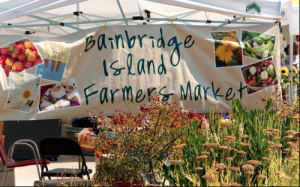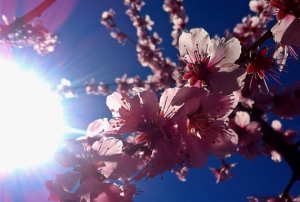2015 Summer Farmers’ Market Season
March 24th, 2015

A unique time of year is upon us, when the earth’s soil thaws and new life sprouts from the fertile soil; birds chirp all day long beneath the shady trees while the sun moves slowly across the sky; it’s not only light enough, but also warm and dry enough to enjoy dinner and wine on the porch with family and friends. Spring means abundance, spring means life, spring means the opening of the summer farmers’ markets! So, next time you plan a sunset dinner on the front lawn, consider the nutrient-rich, homegrown, made-with-love goods that you can find not only on the island but on the Kitsap Peninsula.
Local farmers and venders producing such specialties as handmade clothing, kombucha, wine, chocolate, and oils didn’t stop when last year’s farmers markets did. While winter harvests have been sold in CSA boxes and at grocery stores, the most exciting part of the year, not only for farmers, but for consumers, too, will begin on Saturday, April 11, from 9:00 AM – 1:00 PM, at the opening of the 2015 summer Bainbridge Island Farmers’ Market at the Town Square/City Hall.
With more than 40 venders offering fresh produce, delicious specialty foods, vibrant flowers and plants, crafts, desserts, and much more beneath what we can hope will be bright blue skies, your Saturdays are about to get a little healthier and more full of community fun! Trade your car for a long walk, near or far, across the beautiful island with a few bags, an empty stomach, and plenty of time to spend getting to know your neighbors, venders, farmers, and listen to the rotating live band while eating lunch on the warm, grassy lawn.
Local food venders featured at the Bainbridge Island Summer Farmers’ Market include but are not limited toe: B.I. Barbeque, Clara’s Wok, Rolling Bagels, Psychedeli, Bainbridge Vineyards, and Emmy’s Veggie House, as well as the abundance of samples from venders such as Iggy’s Foods, peddling the most delicious fermented health food this side of the Sound, as well as Mt. Townsend Creamery, F/V Ocean tuna, artisan peanut butter from Jammin PB, and many more. Crafters such as Gayle Bair Pottery, OHO Clothing & Accessories, Bapa Toms Metal Works, Laura’s Knitting Loft, Fern & Folly, Kuy Glass, and Wood Turning by Design offer a wide variety of goods, from pottery to fibers and blown glass.
Farmers—the reason for the season—present at the farmers’ market include: Bainbridge Island Farms, Butler Green Organics, Central Valley Nursery, Farmhouse Organics, Holly Lane Gardens, Laughing Crow Farm, Leapfrog Farm & Medical Intuitive Massage, Paulson Farms, Persephone Farm, Sol Farm, Sundown Ridge Farm, Sweetlife Farm, Tani Creek Farm, and Terra Bella Farms.
The opening of the island market will be closely followed by the following Kitsap Peninsula Markets that will have you covered from Tuesday to Saturday every week:
- Port Orchard Farmers’ Market Saturdays: opens April 4, from 9:00 AM – 2:00 PM
- Poulsbo Farmers’ Market Saturdays: opens April 4, from 9:00 AM – 3:00 PM
- Silverdale Famers’ Market Tuesdays: opens April 28, from 10:00 AM – 4:00 PM
- Kingston Farmers’ Market Saturdays: opens May 2, from 10:00 AM – 2:00 PM
- Bremerton Farmers’ Market Thursdays: opens May 7, from 4:00 – 7:00 PM
- Bremerton Farmers’ Market Sundays: opens May 24, from 10:30 AM – 2:30 PM
Contributed by Christine St.Pierre
Natural Allergy Relief: A pre-Equinox Food & Herb Guide
March 6th, 2015

Contributed by Christine St.Pierre
On Friday, March 20, the sun will shine directly on the equator, and the length of day and night will be nearly equal. While we in the northern hemisphere celebrate the coming of spring with festivals and holidays, the southern hemisphere experiences the autumnal equinox, parting with the long, warm days of summer. The equinox has long been celebrated by many cultures as a time of rebirth, and nature certainly agrees. An incoming breeze is winter’s yawn rushing over the land and sea as the earth awakens with thawing soil, budding trees, and blooming flowers—but with the buds and the blooms must come pollen, spores, and allergens.
Fortunate are the few who don’t experience seasonal allergies. For the rest of us, it’s easy—and expensive—to wander into the nearest drug store, purchase over-the-counter pharmaceuticals, and spend the next few weeks in a haze until the pollen settles. Time is of the essence, and you just want to feel better—now! But, the secret to enjoying every ounce of beauty and sunshine that spring offers without sneezing your way through the day is to prevent allergy symptoms rather than treat them.
Truth be told, most alternative forms of medicine are as common as the groceries in your refrigerator or the flowers in your garden; food, herbs, and common weeds are among the many variations of natural medicine.
Herbal Remedies
Quercetin has been most historically used as a coloring pigment within the plant kingdom. Abundant in red wine, quercetin is the substance mostly responsible for the myth that people who drink red wine live longer, healthier lives. This substance is also a key factor in reducing the amount of the defense mechanism histamine released by mast cells, causing irritation and inflammation. Along with wine and grapes, citrus fruits, red onions, apples, tomatoes, parsley, broccoli, lettuce, and teas are incredibly high in quercetin. Although these foods are loaded with the substance, supplements are necessary to build up enough of the compound. Begin a suggested dose of 1000 milligrams a day between meals six weeks before allergy season.
Echinacea is an aesthetically pleasing flower with healing properties worthy of universal praise. A calming herb, echinacea is commonly used to treat upper respiratory infections. At first sign of heavy breathing or clogged bronchial tubes, begin consuming echinacea in the form of pills or tea.
Stinging Nettle, a common weed found in most yards, is a trendy super food and also a natural antihistamine that doesn’t have the same side effects of dry mouth and drowsiness as pharmaceutical antihistamines. Freeze dried nettle extract is sold in capsules, but making your own nettle products is incredible easy. If consumed in capsule form, 300 milligrams a day will provide relief for three to five hours.
Nettle can also be consumed as tincture, incorporated into food, or sipped as a tea. To make nettle tea, simple boil the leaves in water. Add peppermint leaves for added allergy relief. If you’re planning on putting nettle into food be sure to boil the nettle first to avoid the small, stinging hairs that cause skin inflammation and feel like you rubbed your hand on fiberglass. I suppose it goes without saying that gloves should be worn if and when handling nettle.
A perennial herb called goldenseal, also known as orange root, is often used to boost the effects of other medicinal herbs used for cancer or digestion treatment. Goldenseal increases secretion of mucous membranes to flush out passageways but also contains astringent factors that counter the flow, which counterbalances to aid in a runny nose. This mucous membrane tonic mixed with freeze-dried stinging nettle and saline solution is a magical elixir to cleanse mucous out of passageways. Drop a few drops of goldenseal underneath your tongue and hold the tincture there for a few minutes.
Food as Medicine
Consumption of the appropriate vitamins and supplements during pollen and mold season can be easily incorporated into your daily meals. Foods high in omega-3 fatty acids, particularly in conjunction with Vitamin C, such as cold-water fish, walnuts, flaxseed oil, grass-fed meats, and eggs, are natural anti-inflammatory agents that will help to calm skin and other organs that tend to flare up during allergy season. One ounce of walnuts a day, whether drizzled over pancakes in the morning or blended into a veggie burger patty, and one tablespoon of flaxseed oil two to three times a day are adequate servings of the omega-3’s. Vitamin C, in its many forms, is a natural heal-all with tastiness to boot. An additional 1,000 milligrams of Vitamin C has been known to lower the levels of histamine in the blood, so consider consuming more kiwifruit, oranges, broccoli, and bell peppers.
Live cultures called probiotics keep the immune system strong and build resistance to allergic reactions. Found in things like kombucha, plain yogurt, kefir (fermented goat milk and grains), sauerkraut, dark chocolate, microalgae like spirulina or chlorella, miso, pickles, tempeh, and kimchi, probiotics are the live soldiers you send into your immune system to ward off sticky pollens. Local honey is thought to have a similar effect. Although the theory is not scientifically proven, the idea of consuming local pollen collected by bees native to your area acts as an allergy shot, implementing your allergies into your body so that your cells can adjust to the presence of the allergen and build immunity. Similarly, an old wives’ tale boasts that drinking goat’s milk after the herd has grazed on local pollinators (it even works for poison ivy) builds immunity.
Garlic, every meal’s lifesaver, scares off mosquitos, vampires, and a runny nose. Along with extreme heart health, the spicy nasal feel of garlic will surely clean out your tubes after a bite or two. Horseradish, chili peppers, hot mustard, hot ginger, cayenne pepper, onion, and wasabi also keep passageways clear because of their spicy sting. Carotenoids are another key factor to a diet that prevent the inflammation of airways, so a diet filled with things like apricots, pumpkin, carrots, sweet potatoes, spinach, kale, butternut squash, and collared greens is sure to keep the airways open.
What to Avoid
As important as it is to consume healthy foods and appropriate vitamins to build immunity to and treat allergy symptoms, refraining from certain foods will also boost your immunity to the season’s nasty allergens. Eliminate foods that cause any stomach upset or mild breakouts.
Those allergic to ragweed should avoid melon, banana, cucumber, sunflower seeds, chamomile, and echinacea. Grass allergies should avoid raw celery, oranges, apples, tomatoes, and peaches, as well as wheat, corn, rice, barley, millet, rye, oats, sugar, and bananas. Beet sugar is fine, but most raw sugars consist of cane, so be cautious that raw or organic does not necessarily mean “beet.” Buckwheat flower, arrowroot, and nutritional yeast are wonderful substitutes for the thickeners and seeds that those with grass allergies must avoid. Reduce foods rich in arachidonic acid, such as egg yolks, shellfish, and some red meats, as a recent study associates these acids with allergies and hay fever.
Also remember that natural remedies can be toxic when consumed in large quantities and absolutely do not mix natural treatments with pharmaceutical drugs. Allegra, an antihistamine, coupled with an antihistaminic product like quercetin could supply too much activity, resulting in significant problems such as glaucoma, ulcers, bladder infections, hyperthyroidism, high blood pressure, deliriousness or hallucinations, and heightened side effects like incredible drowsiness or fatigue.
Inhale Essential Oils, Exhale Relief
Steam inhalation is another quick fix for allergic congestion. Inhaling the steam of essential oils will clear your nasal passages and open your lungs. Simply fill a saucepan with water and bring to a boil. Once the boil begins to roll, turn off the heat and remove the pan. Add three drops of eucalyptus oil, three drops of rosemary extract, two drops of myrtle, and two drops of tea tree oil to the hot water. Tent a bath towel over your head as you lean over the steamy water and inhale deeply for five to ten minutes in the morning and at night. Relief will not be long lasting, so repeat up to three times a day if necessary.